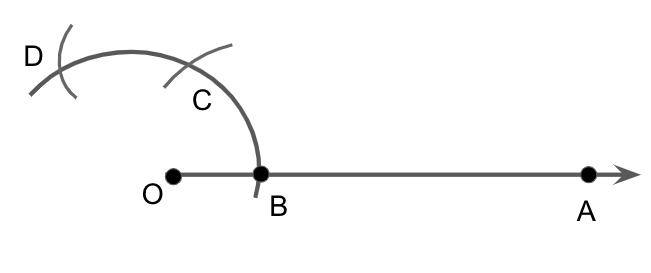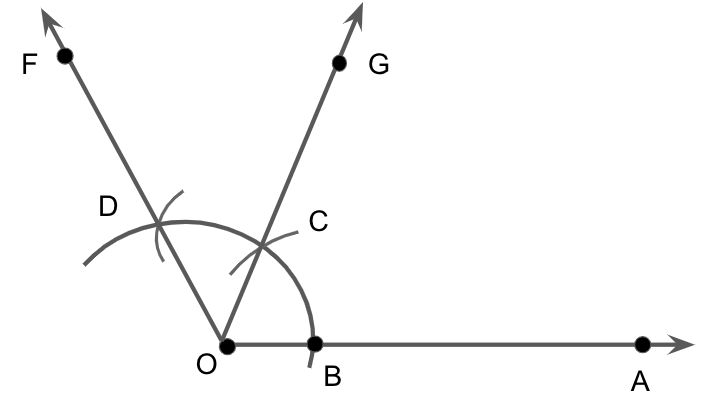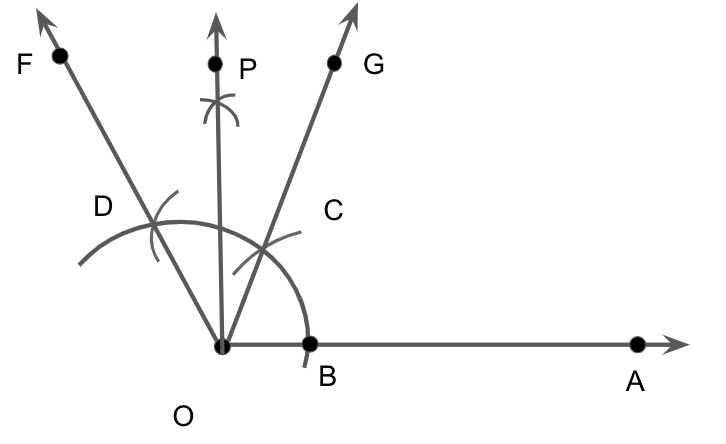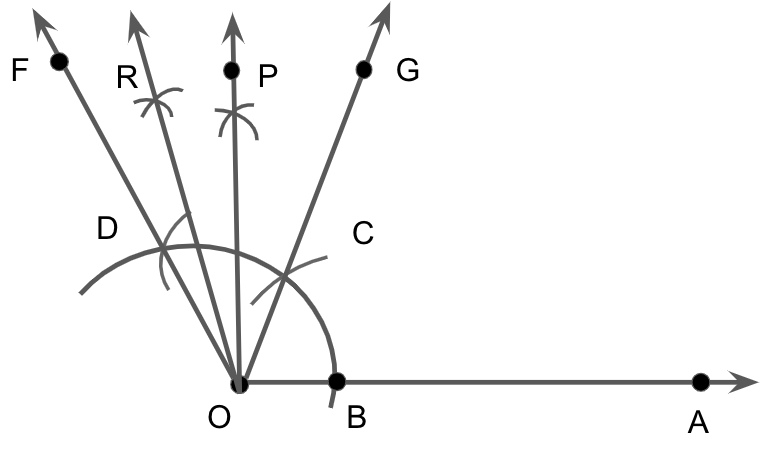
Construct the following angles and verify by measuring them by a protector: \[105^\circ \]
Answer
572.1k+ views
Hint: Here, we will make the given angle in \[90^\circ \] and then a bisector of \[30^\circ \]. First, we will draw a ray OA and then taking O as center and any radius, draw an arc cutting OA at B. Then with B as center and same radius as before, we will draw an arc intersecting the previously drawn arc at point C and with C as center, same radius, draw another arc intersecting the previously drawn arc at point D. Then we will draw ray OE passing through C and a ray OF passing through D and take C and D as center, with radius more than \[\dfrac{1}{2}CD\], we will draw arcs intersecting at P and join OP. Then taking Q and C as center, with radius more than \[\dfrac{1}{2}QC\], we will draw arcs intersecting at R and join OR to find the required angle.
Complete step-by-step answer:
We are given that the angle is \[105^\circ \].
Rewriting the given angle, we get
\[
\Rightarrow 105^\circ = 90^\circ + 15^\circ \\
\Rightarrow 105^\circ = 90^\circ + \dfrac{{30^\circ }}{2} \\
\]
So to make the given angle, we will make \[90^\circ \] and then a bisector of \[30^\circ \].
First, we will draw a ray OA.

Taking O as center and any radius, draw an arc cutting OA at B, we get

Now with B as center and same radius as before, we will draw an arc intersecting the previously drawn arc at point C and with C as center, same radius, draw another arc intersecting the previously drawn arc at point D, we get

We will now draw ray OE passing through C and a ray OF passing through D, we get

Thus, we have \[\angle AOE = 60^\circ \] and \[\angle EOF = 60^\circ \].
Now we bisect \[\angle EOF\] twice as \[60^\circ \to 30^\circ \to 15^\circ \].
Taking C and D as center, with radius more than \[\dfrac{1}{2}CD\], we will draw arcs intersecting at P and join OP, we get

Thus, we have \[\angle AOP = 90^\circ \] and \[\angle POD = 30^\circ \].
Now we bisect \[\angle POD\] twice as \[\dfrac{{30^\circ }}{2} = 15^\circ \] and mark point Q where OP intersects the arc.
Taking Q and C as center, with radius more than \[\dfrac{1}{2}QC\], we will draw arcs intersecting at R and join OR, we get

Therefore, \[\angle AOR = 105^\circ \].
On measuring this angle \[\angle AOR\] by protractor, we find that \[\angle AOR = 105^\circ \].
Hence, verified.
Note: The crucial part of this problem is to use the compass properly. One needs to know the basic rules and way of using a compass. We will verify our angle by using the protractor and putting it on the line OA with O as a center. This is a simple problem, we have to be careful with the labeling of the arcs as well.
Complete step-by-step answer:
We are given that the angle is \[105^\circ \].
Rewriting the given angle, we get
\[
\Rightarrow 105^\circ = 90^\circ + 15^\circ \\
\Rightarrow 105^\circ = 90^\circ + \dfrac{{30^\circ }}{2} \\
\]
So to make the given angle, we will make \[90^\circ \] and then a bisector of \[30^\circ \].
First, we will draw a ray OA.

Taking O as center and any radius, draw an arc cutting OA at B, we get

Now with B as center and same radius as before, we will draw an arc intersecting the previously drawn arc at point C and with C as center, same radius, draw another arc intersecting the previously drawn arc at point D, we get

We will now draw ray OE passing through C and a ray OF passing through D, we get

Thus, we have \[\angle AOE = 60^\circ \] and \[\angle EOF = 60^\circ \].
Now we bisect \[\angle EOF\] twice as \[60^\circ \to 30^\circ \to 15^\circ \].
Taking C and D as center, with radius more than \[\dfrac{1}{2}CD\], we will draw arcs intersecting at P and join OP, we get

Thus, we have \[\angle AOP = 90^\circ \] and \[\angle POD = 30^\circ \].
Now we bisect \[\angle POD\] twice as \[\dfrac{{30^\circ }}{2} = 15^\circ \] and mark point Q where OP intersects the arc.
Taking Q and C as center, with radius more than \[\dfrac{1}{2}QC\], we will draw arcs intersecting at R and join OR, we get

Therefore, \[\angle AOR = 105^\circ \].
On measuring this angle \[\angle AOR\] by protractor, we find that \[\angle AOR = 105^\circ \].
Hence, verified.
Note: The crucial part of this problem is to use the compass properly. One needs to know the basic rules and way of using a compass. We will verify our angle by using the protractor and putting it on the line OA with O as a center. This is a simple problem, we have to be careful with the labeling of the arcs as well.
Recently Updated Pages
Master Class 9 General Knowledge: Engaging Questions & Answers for Success

Master Class 9 English: Engaging Questions & Answers for Success

Master Class 9 Science: Engaging Questions & Answers for Success

Class 9 Question and Answer - Your Ultimate Solutions Guide

Master Class 12 Business Studies: Engaging Questions & Answers for Success

Master Class 12 Economics: Engaging Questions & Answers for Success

Trending doubts
What is BLO What is the full form of BLO class 8 social science CBSE

Which one of the following groups comprises states class 8 social science CBSE

Citizens of India can vote at the age of A 18 years class 8 social science CBSE

Full form of STD, ISD and PCO

A couple went for a picnic They have 5 sons and each class 8 maths CBSE

Right to vote is a AFundamental Right BFundamental class 8 social science CBSE




